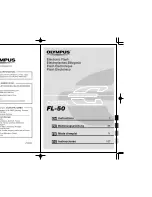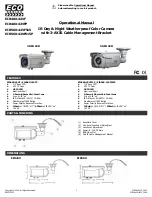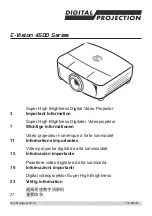
21
Battery Power
The battery power circuit is used to power the camera when the camera is
turned ON and also used to charge the battery when the camera is OFF.
Battery Power Circuit Applications
Conditions
Purpose
Key Signal
No AC adapter. Battery
inserted. Camera is
ON
Power the
camera
IC404/pin 100 output
is HIGH.
AC adapter connected.
Battery not charged.
Camera is
OFF
Charge the
battery
IC404/pin 100 output
is HIGH.
AC adapter connected.
Battery is fully charged.
Camera is
OFF
Test Charge the
battery
IC404/pin 100 output
is 1 sec square wave.
Power the Camera (no AC adapter)
When the battery is connected to power the camera, the battery voltage
must be detected and switched into the camera power path before the
camera will work.
After the battery is inserted, the following takes place:
•
Battery Powers IC404
•
IC404 Detects the Battery only
•
IC404 Completes the Battery Path
•
Battery power is available to the Camera
Battery Powers IC404
Inserting any power source powers IC404. Sliding the NP-F330 or NP-
F550 battery into the compartment applies its 7.2Vdc to F004. This 1.4A
fuse passes the battery voltage into the main FC-72 board. D401 and
D402 are connected as an OR gate to pass either the battery or DC In
voltage. The higher voltage is applied to the Ever 3.2V regulator IC401.
IC401’s output powers main HI Control IC404.
IC404 Detects the Battery Only
Now that the Active Ever 3.2V line powers HI Control IC404, it detects
battery voltage at pin 71 from F004 with the camera still off. IC404’s next
step is dependent upon whether the AC power is detected at pin 72. If
both voltages at pins 71 and 72 are present, battery charging begins. If
only the battery is present, IC404 completes the battery power path to
power the camera.
IC404 Completes the Battery Power Path
The final step is for IC404 to switch on Q001 and Q004 when the camera
is powered ON. These transistors will divert the battery voltage into the
camera’s power supply via fuses F001, F002, F003 and F005 (some fuses
are not shown for simplicity).
When the camera is turned ON with the battery alone detected, IC404
outputs a High at pin 100. This control voltage enters the FU board to
turn on N channel MOSFET Q004. The 3.2V from IC404/pin 100 is re-
duced by R006 to 1.6V at Q004’s gate. The positive gate voltage turns on
the N channel device so it conducts. The resultant 0V at Q004’s Drain is
applied to the gates of P channel Q001, also turning them both ON. When
Q001 conducts, its D-S resistance drops, causing the battery voltage to
be connected through the fuse line into the camera’s power supply.
Although power is now presented to the power supply, the power supply
needs a DD ON signal from IC404 to produce the voltages necessary to
turn ON the camera.
Battery Power Checklist
Test Point
Voltage
Purpose
Floppy Drive case
0Vdc
Ground point
CN001/pin 8
7.2V
Battery voltage Input to Main
FC-72 board
CN001/pin 3
3.2V
Battery On Switch Output from
FC-72 board
Q004/Drain
0Vdc
Proves Q004 is OK
Fuses (except F004)
7.2Vdc
Proves Q001 is OK
















































